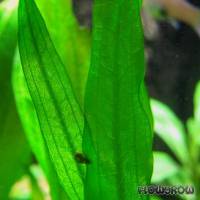



Echinodorus berteroi is an uncommon sword plant and differs very much from the other Echinodorus species in many aspects. It is distributed from the Midwest of the USA southwards to central Argentine (Patagonia), and it is especially frequently found on the Caribbean Islands. It mainly grows in temporary waterbodies like bogs and ponds that dry out over the longest part of the year. There it is an annual plant, as a rule, that needs only a few months for its entire life cycle - from seed germination that takes place when the waterbody starts filling in the moist season until its fruit ripens and the plant dies off when the location dries out. However, E. berteroi can also be cultivated as a perennial.
Whereas this plant was frequently found in trade some decades ago, it is only rarely cultivated today. Its relatively time-consuming propagation by seed (see below) and the submersed rearing the young plants require is not economical for today's aquatic plant nurseries.
The submersed leaves of E. berteroi are very variable and assume different forms on the same plant during their development. At first they are band-shaped and have a short stem, and after that they get lanceolate to narrowly ovate, and finally they develop long stems and assume an oval to ovate form, with a round to heart-shaped base. The leaves are very thin, fragile and slightly transparent (which is the reason why one of its vernacular names is cellophane plant), they are often irregularly undulate and twisted and have a light green gridlike venation contrasting nicely against the darker leaf tissue. New leaves are light green to reddish green at first and assume a darker colour later on.
Its long-stalked floating and aerial leaves are longish ovate to roundish heart-shaped. The leaf stalk cross section is triangular.
The flower stalks grow upright and ramify. They can grow over 40 cm in height and look quite similar to the inflorescence of Alisma. They only appear when the plant has the chance to form emersed leaves, and usually do not sprout any adventitious plants. The flowers are relatively small and inconspicuous. After the flowers wilt, the plant grows its prickly infrutescence (even without artificial pollination) containing many nutlets with seeds that are able to germinate even after at least a year, given that they have been stored dry.
This Echinodorus species is very decorative when cultivated as a submersed plant, however, when kept in an aquarium it has the grave drawback of soon forming floating and aerial leaves as well as inflorescence when kept under long-day conditions (over 12 hours of light per day). If this is allowed to happen, the submersed leaves soon die off. It can be prevented or at least delayed by keeping the plant at short-day conditions, though (uninterrupted dark period of over 13 hours per day).
Apart from that, E. berteroi is relatively easy in cultivation. It does well in hard to soft water, under moderate to high light intensities, and at temperatures of 20 to 27 °C, ideally. Lower temperatures are also tolerated. A substrate rich in nutrients is recommendable. If the CO2 content of the water is very low, a white to light gray lime coat may develop on the leaves due to biogenic decalcification. The tender new leaves are a favourite food of some snails.
E. berteroi can be propagated in large numbers by seed. The dry nutlets containing the seeds can be sown in any kind of container (aquarium, vase, ...) with water and a substrate, e.g. a mixture of sand and loam. They will float at first, but then they sink to the ground by and by. The seeds inside the nutlets germinate after varying periods of time. The seedlings then are best cultivated submersed in order to get larger, more decorative plants. Young plants cultivated emersed stay smaller and form flower stalks early on.
On the basis of older submersed plants, often daughter rosettes may form, which can be separated from the mother plant when they have grown strong enough.
Even though larger groups of smaller specimens of this species may fit into a 100 litre tank, a single adult plant will need two thirds of a 300 litre tank.
There may be no special purpose this plant is used for in aquascaping, however, it is a great filler or background plant. Younger specimens of this sword plant may be placed in the middleground of a layout, where their impressive transparent foliage complements colourful fish really well. In open tanks and paludaria, the emersed form can be cultivated. It does not grow as massively as e.g. E. cordifolius or E. palaefolius, and its round to heart-shaped leaves and ramified flower stalks can have an interesting effect. E. berteroi can also be used as a great model to display photoperiodism (the reaction to different day lenghts) and heterophylly (the occurence of different leaves in one plant).
<a href="https://www.flowgrow.de/db/aquaticplants/echinodorus-berteroi" target="_blank"><img alt="Echinodorus berteroi" title="Echinodorus berteroi" src="https://www.flowgrow.de/db/widget/aquaticplants/echinodorus-berteroi" /></a>
[url=https://www.flowgrow.de/db/aquaticplants/echinodorus-berteroi][img]https://www.flowgrow.de/db/widget/aquaticplants/echinodorus-berteroi[/img][/url]
[widget=aquaticplants/echinodorus-berteroi]Echinodorus berteroi[/widget]